Platform screen doors
This article needs additional citations for verification. (April 2020) |
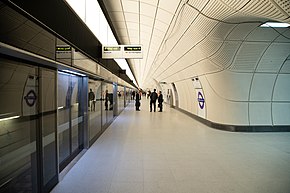
Platform screen doors (PSDs), also known as platform edge doors (PEDs), are used at some train, rapid transit and people mover stations to separate the platform from train tracks, as well as on some bus rapid transit, tram and light rail systems. They are primarily used for passenger safety.[1] They are a relatively new addition to many metro systems around the world, some having been retrofitted to established systems. They are widely used in newer Asian and European metro systems, and Latin American bus rapid transit systems.
History[]
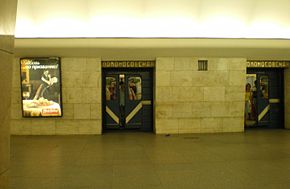
The idea for platform edge doors dates as early as 1908, when Charles S. Shute of Boston was granted a patent for "Safety fence and gate for railway-platforms".[2] The invention consisted of "a fence for railway platform edges", composed of a series of pickets bolted to the platform edge, and vertically movable pickets that could retract into a platform edge when there was a train in the station.[3] In 1917, Carl Albert West was granted a patent for "Gate for subrailways and the like".[4] The invention provided for spaced guides secured to a tunnel's side wall, with "a gate having its ends guided in the guides, the ends and intermediate portions of the gate having rollers engaging the side wall". Pneumatic cylinders with pistons would be used to raise the gates above the platform when a train was in the station. Unlike Shute's invention, the entire platform gate was movable, and was to retract upward.[5]
The first stations in the world with platform screen doors were the ten stations of the Saint Petersburg Metro's Line 2 that opened between 1961 and 1972. The platform "doors" are actually openings in the station wall, which supports the ceiling of the platform. The track tunnels adjoining the ten stations' island platforms were built with tunnel boring machines (TBMs), and the island platforms were actually located in a separate vault between the two track tunnels. Usually, TBMs bore the deep-level tunnels between stations, while the station vaults are dug out manually and contain both the tracks and the platform. However, in the case of the Saint Petersburg Metro, the TBMs bored a pair of continuous tunnels that passed through ten stations, and the stations themselves were built in vaults that only contained the platform, with small openings on the sides of the vault, in order for passengers to access the trains in the tunnels.[6]
Singapore's Mass Rapid Transit opened in 1987 is often described as the first heavy metro system in the world to incorporate PSDs into its stations for climate control and safety reasons, rather than due to architectural constraints,[6][7][8] though the light Lille Metro opened in 1983 predates it.[9]
Types[]


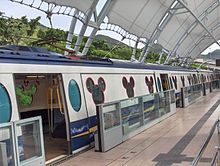

Although the terms are often used interchangeably, platform screen doors can refer to both full-height and half-height barriers. Full height platform screen doors are total barriers between the station floor and ceiling, while the half-height platform screen doors are referred to as platform edge doors, as they do not reach the ceiling and thus do not create a total barrier. Platform gates are usually only half of the height of the full-screen doors, but they sometimes reach to the height of the train. These two types of platform screen doors are presently the main types in the world.
Platform screen doors and platform edge doors[]
These doors help to:
- Prevent people from accidentally falling onto the tracks, getting too close to moving trains, and committing suicide (by jumping) or homicide (by pushing).[10]
- Prevent or reduce wind felt by the passengers caused by the piston effect which could in some circumstances make people lose their balance.
- Improve safety—reduce the risk of accidents, especially from trains passing through the station at high speeds.[10]
- Improve climate control within the station (heating, ventilation, and air conditioning are more effective when the station is physically isolated from the tunnel).[10]
- Improve security—access to the tracks and tunnels is restricted.[10]
- Lower costs—eliminate the need for motormen or conductors when used in conjunction with Automatic Train Operation, thereby reducing manpower costs.
- Prevent litter buildup on the tracks, which can be a fire risk, as well as damage and possibly obstruct trains.[11]
- Improve the sound quality of platform announcements, as background noise from the tunnels and trains that are entering or exiting is reduced.
- At underground or indoor platforms, prevent the air from being polluted by the fumes caused by friction from the train wheels grinding against the tracks.[12]
Their primary disadvantage is their cost; installing a system typically costs several million USD per station. When used to retrofit older systems, they limit the kind of rolling stock that may be used on a line, as train doors must have exactly the same spacing as the platform doors; this results in additional costs due to depot upgrades and otherwise unnecessary purchases of rolling stock.
The doors also pose their own safety risks. The primary risk is that people may be trapped between the platform doors and the train carriage, and be subsequently crushed when the train begins to move (see § Incidents). Cases of this happening are rare, and may depend upon door design.
Automatic platform gate[]
Half-height platform doors, or automatic platform gates, are chest-height sliding doors at the edge of railway platforms to prevent passengers from falling off the platform edge onto the railway tracks. Like full-height platform screen doors, these platform gates slide open or close simultaneously with the train doors.
Half-height platform gates are cheaper to install than platform screen doors, which require more metallic framework for support. Some railway operators may therefore prefer such an option to improve safety at railway platforms and, at the same time, keep costs low and non-air-conditioned platforms naturally ventilated. However, these gates are less effective than full platform screen doors in preventing people from intentionally jumping onto the tracks.[13]
These gates were first in practical use by the Hong Kong metro system on the Disneyland Resort line for their open-air station design. The later design by other manufacturers, such as Manusa, or Gilgen Door Systems AG, have their gates higher than the ones installed on the Disneyland Resort line.
Rope-type screen doors[]
There are also rope-type platform screen doors, initially installed in some stations in South Korea and Japan, where multiple train types with different length and train door structures use the same platforms. The barriers move upwards, rather than sideways, when letting passengers through.[14]
Use[]
Argentina[]
Line D of the Buenos Aires Subte is planned to have platform screen doors installed in the future as soon as the CBTC system is installed.[15][16][17]
Australia[]

Bella Vista railway station In Sydney Metro

Rouse Hill Station on the Sydney Metro

The Epping to Chatswood section of the network was converted from a suburban line

Norwest railway station In Sydney Metro

Sydney Metro In Hills Showground

Castle Hill railway station In Sydney Metro
Sydney Metro Northwest, the initial section of the Sydney Metro, which opened in May 2019, was the first-fully automated rapid transit rail system in Australia. Full-height screen doors are provided on most underground platforms, with half-height doors on at-grade, elevated and some underground platforms. The existing five stations on the Epping to Chatswood railway line were upgraded to rapid transit standard, all being fitted with half-height platform screen doors.[18]
In Melbourne, the Metro Tunnel, from South Kensington to South Yarra, due to open in 2025, will have platform screen doors on the underground stations.[19] New rolling stock is being constructed, with doors that will line up with full-height ones on the platforms.
The Cross River Rail in Brisbane, which is currently under construction and scheduled to open in 2024, will have platform screen doors on the new Boggo Road, Woolloongabba, and Albert Street underground stations, and the new underground platforms of Roma Street.[20]
Austria[]
Line U2 of the Vienna U-Bahn is being reconstructed from Schottentor station to Karlsplatz station, with the addition of platform screen doors to the reconstructed stations by 2023-2024.[21]
Belarus[]
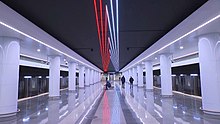
Platform screen doors are being added to Line 3 of the Minsk Metro, which opened in late 2020.[22]
Brazil[]
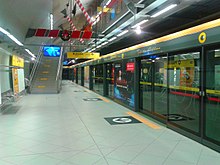
The Platform Screen Doors are present in the São Paulo Metro since 2010, when the Sacomã Station was opened.[24] As of 2019, 5 of the 6 lines of the São Paulo Metro have the equipment: Line 4 - Yellow and Line 15 - Silver have the equipment installed in all of its stations. The feature is also present in some stations of Line 2 - Green, Line 3 - Red and Line 5 - Lilac. They are planned to be installed in 41 stations of lines 1, 2 and 3 by the end of 2021,[25] as well as all stations of line 5 by the end of 2020.[26]
PSDs are also found on the tube stations of the RIT BRT and in the Santos Light Rail since 2016.[27]
Bulgaria[]
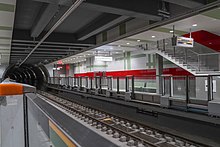

Half-height platform screen doors are in use on all stations of the Sofia Metro Line 3.[28]
In 2020, Rope type Screen Door (RSD) system was installed in Vasil Levski Stadium Metro Station and Opalchenska Metro Station of the Sofia Metro Line 1 and Line 2. In total, such rope type safety barriers will be installed on more 10 of the busiest stations on the Line 1 and 2 of the Sofia Metro, providing increased safety for passengers and protecting against accidental falls. [29]
Canada[]
Screen doors are in use at all three LINK Train stations and the Union and Pearson stations along the Union Pearson Express route to Toronto Pearson International Airport in Mississauga, Ontario.
Greater Montreal's forthcoming Réseau express métropolitain (REM), the 67-kilometre-long driverless complementary suburban rapid transit network opening in five phases between 2022 and 2024 will feature screen doors at each of its 26 stations.
With the advent of the REM on the horizon, advocating retrofits of platform edges in the Montreal Metro with doors to combat delays attributed to overcrowding is becoming increasingly customary. Were its type of door to be screen (full-height), then such installations might quash the fully underground system's notoriety whereby opening or passing through station entrance doors proves mightily troublesome due to the excessive windiness brought about by arriving or departing trains.[citation needed] Given the fact that there are two different door layouts on the Montreal Metro, with the older MR-73 trains having 4 doors on each side of the car, and MPM-10 having 3, it is unlikely platform doors will be showing up in the Montreal Metro in the near future.
Chile[]
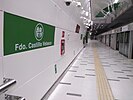
Fernando Castillo Velasco metro station In Line 3 In Santiago Metro

Line 6 of the Santiago Metro, inaugurated in November 2017, introduced the platform doors and converted it into one of the most modern in Latin America
Platform edge doors are currently in use at Lines 3 and 6 of the Santiago Metro, being a novelty in the system.
China[]
All Chinese metro systems have platform screen doors installed on most of their lines. All stations built after the mid 2000s have some form of platform barrier. Only the Nanjing Metro, Dalian Metro and Wuhan Metro have stations without the platform screen doors on their early lines (As of 21 September 2019). However many are starting the process of retrofitting these lines with platform screen gates. In addition, many BRT systems such as the Guangzhou Bus Rapid Transit are also equipped with platform screen doors. Platform screen doors are also present in some tram and light rail stops such as the Xijiao Light rail, Nanjing tram and Chengdu tram. Several underground high speed railway stations of the CRH network use platform screen doors set back from the platform edge.
Colombia[]
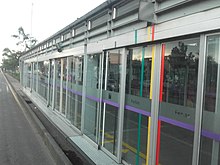
Several stations on Bogota's TransMilenio bus rapid transit system use platform screen doors.
Denmark[]
The Copenhagen Metro uses Westinghouse[30] and Faiveley platform screen doors on all platforms. Full-height doors are used on underground stations while surface level stations have half-height doors (except Lufthavnen).
Deep-level station design at Forum In Copenhagen Metro

Lufthavnen Station serves Copenhagen Airport

Poul Henningsens Plads Station In Copenhagen Metro

Vibenshus Runddel Station In Copenhagen Metro
Finland[]
The Helsinki Metro had a trial run with Faiveley automatic platform gates installed on a single platform at Vuosaari metro station during phase one of the project. The doors, which are part of the Siemens metro automation project, were built in 2012. Phase 2 of the project has been delayed due to metro automation technical and safety related testings.[31] The doors were removed in 2015.
France[]

Fully enclosed platform screen doors in 14 in Paris Métro

Platform view In Saint-Ouen
A VAL208 at François-Verdier station In Toulouse Metro

Platform curtains at Vanves–Malakoff station
All lines of the VAL automated subway system are equipped with platform screen doors at every station, starting with Lille subways in 1983. Those also include Toulouse and Rennes as well as the CDGVAL and Orlyval airport shuttles.
Paris Métro's line 14 from Saint-Lazare to Bibliothèque François Mitterrand was inaugurated in 1998 with platform screen doors manufactured by Faiveley Transport. The new station Olympiades opened with platform screen doors in June 2007. Line 1 has been retrofitted with platform edge doors, for full driverless automation effective in 2012. Some stations on Line 13 have had platform edge doors since 2010 to manage their overcrowding, after tests conducted in 2006, and stations on Line 4 are currently being fitted with platform edge doors in preparation for its automation.
Since 30 June 2020, a new kind of vertical platform screen doors, called platform curtains, are being tested on the platform 2bis of Vanves–Malakoff station (in Paris region) on the Transilien Line N commuter rail line. The experiment should end in February 2021.[32] These 1.6 meter high vertical doors are manufactured by HENGZHU.[citation needed] Transilien said that they preferred platform curtains to classical screen doors for this line because the positioning of the doors is not the same across the rolling stock, and that they plan to install them in other Transilien stations if the experiment is successful.[33]
Germany[]
People movers at Frankfurt International Airport, Munich International Airport and Düsseldorf Airport are equipped with platform screen doors, as well as the suspended monorail in Dortmund, called H-Bahn. Plans are underway to test platform screen doors on the Munich U-Bahn in 2023 and line U5 & U6 will be installed in late 2026.[34]
Greece[]
Platform screen doors will be used on the driverless Thessaloniki Metro,[35] which opens in November 2023.
Hong Kong[]

East Tsim Sha Tsui station has the longest set of platform screen doors in the world, but a third have been out of service since the station began serving shorter trains on the West Rail line (now Tuen Ma line) in 2009.

HK Lohas Park Station 康城站 (香港)

MTR Causeway Bay station platform
Today, all heavy rail platforms except those on the East Rail line have either platform screen doors or platform edge doors. Platform edge doors are only used on above-ground stations, while platform screen doors are used in both underground and above-ground stations. None of the light rail platforms have platform screen doors or platform edge doors.
In 1998, the Tung Chung line and Airport Express saw the earliest operations of platform screen doors in Hong Kong.
The MTR Corporation had also, since mid-1996, been studying the feasibility of installing PSDs at the older stations. It decided in 1999 to undertake the PSD Retrofitting Programme at 74 platforms of 30 underground stations on the Kwun Tong, Island, and Tsuen Wan lines. This was completed in early 2006.[36] The Mass Transit Railway was the first metro system in the world to retrofit PSDs on a transit system already in operation.[37]
In 2006 the MTR began studying ways to introduce barriers at above-ground and at-grade stations, which was considered more complicated as these stations are naturally ventilated and the introduction of platform screen doors would entail the installation of air conditioning systems. In 2008 the corporation decided to install automatic platform gates at these eight stations (the MTR and KCR Corporation were operationally merged in 2007, but KCR stations were except from this study).[36] The eight stations were retrofitted with APGs in 2011.
From July 2000 to December 2013, the MTR Corporation collected a surcharge of 10 cents from each Octopus-paying passenger to help pay for the installation of PSDs and APGs. Over HK$1.15 billion was collected in total.[38]
Platform screen doors were also installed on all platforms of the West Rail line (now part of the Tuen Ma line), then built by the Kowloon-Canton Railway Corporation (KCRC) before the MTR–KCR merger. The Ma On Shan line did not have gates upon opening even though it was built at the same time as the West Rail; they were eventually added from 2014 to 2017 prior to the opening of the first phase of the Tuen Ma line on 14 February 2020.
The installation of platform screen doors in Hong Kong has been effective in reducing railway injuries and service disruptions.[39]
The longest set of platform screen doors in the world can be found in East Tsim Sha Tsui station.[40] A reduction of train length from 12 to 7 cars following the construction of Kowloon Southern Link caused many of the screen doors to be put out of service, although the trains were lengthened to eight cars in May 2018.
The platform screen doors presently in service in the MTR were supplied by the Swiss manufacturer Kaba Gilgen, the Japanese Nabtesco Corporation (under the Nabco brand), as well as Faiveley Transport. The last stations in Hong Kong without platform screen doors or gates are all found on the East Rail line, a former KCR line not part of the MTR APG retrofitting programmes. However, these remaining stations are all being retrofitted by Kaba as part of the Sha Tin to Central Link project.[41] Adding APGs to the East Rail platforms requires platform strengthening as the gates, combined with heavy winds, can greatly increase structural loading on the platform edge.
Apart from the MTR, all stations on the Hong Kong International Airport Automated People Mover are equipped with platform screen doors made from Westinghouse Platform Screen Doors (for Phase 1)[42] and Panasonic (for Midfield Extension).[43]
India[]
On the Delhi Metro, all stations on the Delhi Airport Metro Express line, which links to Indira Gandhi International Airport have been equipped with full-height platform screen doors since November 2015 and the six busiest stations on the Yellow Line have also been equipped with half height platform gates.[44][45] Automatic platform gates on all the stations of the Pink, Magenta Line and Grey Line.
Platform screen doors are also used in all underground stations of the Chennai Metro.[46]
There are platform screen doors in all elevated stations of Kolkata Metro Line 2. Platform screen doors will be introduced in underground stations of Kolkata Metro Line 2, Kolkata Metro Line 3, Kolkata Metro Line 6. There are plans to install platform screen doors also in Kolkata Metro Line 1.[47]
On the Namma Metro in Bangalore, platform doors will be installed for its phase II operations and is expected to be completed by 2019.[48]
On the Mumbai Metro, all lines being made by MMRDA will have half-height platform screen doors on all elevated stations and full-height platform screen doors in the underground stations, as the trains used in these lines have a GoA level 4, and also to reduce risk of passenger deaths by overcrowding. In Line 2A, The Yellow Line, Line 7A, The Red Line & Line 3, the Aqua line, will have full-height platform screen doors, as the line is fully underground, and like the MMRDA lines above, will have GoA level 4 (Unattended train operation).[49] [50] [51] [52]
All stations on the Pune Metro will have platform screen doors. [53]

Full-height platform screen doors installed in Chennai Metro's underground stations

Half-height automatic platform doors in Okhla Bird Sanctuary Station of the Delhi Metro's Magenta Line.

1st day opening east west metro Kolkata Metro's kolkata line 2
Indonesia[]

Platform screen doors at one of SHIA Skytrain station

Platform screen doors at SHIA railway station

Half-height doors at ASEAN MRT station
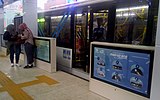
Half-height doors at TransJakarta Bundaran HI station
Italy[]

Platform screen doors at the Monte Compatri-Pantano station on Rome Metro's Line C

Stazione FS station In Brescia Metro
Platform screen doors are used in most newly built rapid transit lines and systems of new construction in Italy. PSDs are present on Turin Metro, the Venice People Mover, the Perugia Minimetrò, the Brescia Metro, Line 5 of the Milan Metro, and Line C of the Rome Metro.
Japan[]
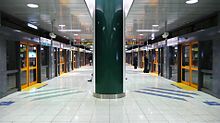
The Tokyo Metro and Toei Subway began using barriers with the 1991 opening of the Namboku Line (which has full-height platform screen doors), and subsequently installed automatic platform gates on the Mita, Marunouchi, and Fukutoshin lines. Some railway lines, including the subway systems in Sapporo, Sendai, Nagoya, Osaka, Kyoto, and Fukuoka, also utilize barriers to some extent.
In August 2012, the Japanese government announced plans to install barriers at stations used by 100,000 or more people per day, and the Ministry of Land, Infrastructure, Transport and Tourism allotted 36 million yen ($470,800) for research and development of the system the 2011-2012 fiscal year. A difficulty was the fact that some stations are used by different types of trains with different designs, making barrier design a challenge.[54]
As of November 2012, only 34 of 235 stations with over 100,000 users per day were able to implement the plan. The ministry stated that 539 of approximately 9,500 train stations across Japan have barriers. Of the Tokyo Metro stations, 78 of 179 have some type of platform barrier.[55][needs update]
In 2018, automatic platform gates will be installed on the Sōbu Rapid Line platforms at Shin-Koiwa. As these trains are 300 m (980 ft) long, it is believed that this will break the world record for the longest platform doors at East Tsim Sha Tsui station in Hong Kong.[56][57][needs update]
Malaysia[]
Platform screen doors (PSD) are installed at all underground Kelana Jaya Line stations, from Ampang Park to Masjid Jamek and Kajang Line, from Muzium Negara to Maluri stations. The automated announcement message reading "For safety reasons, please stand behind the yellow line" in both English and Malay languages are also heard before the train arrived at all stations.
There are also platform screen doors (PSD) on the KLIA Ekspres at Kuala Lumpur Sentral and KLIA stations. Both stations at KLIA Aerotrain also have platform screen doors.
The Platform screen gates (PSG) also have been installed in all elevated stations of the Kajang Line and KL Monorail.

PSD at KLCC station

PSD at Tun Razak Exchange station
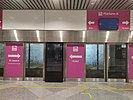
PSD at KLIA

PSD at KLIA Satellite A Building

PSG at Semantan station
Philippines[]
Half-height platform screen doors shall be installed on the North–South Commuter Railway,[58] while full-height platform screen doors shall be installed on the Metro Manila Subway.[59] The system is sought to open in stages between 2022 and 2025.
Peru[]
Full-height platform screen doors will be used in underground stations of Line 2 of the Lima Metro, due to open in 2022.[60]
Qatar[]

Platform screen doors are in use in all stations of the Doha Metro.[61] They are also found on the Lusail tram.
Russian Federation[]
Park Pobedy (Russian: Парк Победы) is a station of the Saint Petersburg Metro that was the first station in the world with platform doors. The station was opened in 1961. Later, nine more stations of this type were built in Leningrad (nowadays Saint Petersburg): Petrogradskaya (Russian: Петроградская), Vasileostrovskaya (Russian: Василеостровская), Gostiny Dvor (Russian: Гостиный двор), Mayakovskaya (Russian: Маяковская), Ploshchad Alexandra Nevskogo I (Russian: Площадь Александра Невского-1), Moskovskaya (Russian: Московская), Yelizarovskaya (Russian: Елизаровская), Lomonosovskaya (Russian: Ломоносовская), and Zvyozdnaya (Russian: Звёздная).
There was an electronic device to ensure that the train stopped with its doors adjacent to the platform doors; they were installed so that driverless trains could eventually be used on the lines.[62] Line 2 uses GoA2 automatic train operation to make this easier, however, Line 3 does not. Unlike other platform screen doors, which are lightweight units with extensive glazing installed on a normal platform edge, the St Petersburg units give the appearance of a solid wall with heavyweight doorways and solid steel sliding doors, similar to a bank of elevators in a large building, and the train cannot be seen entering from the platform; passengers become familiar with the sound alone to indicate a train arrival.
In May 2018, two other similar stations were opened: Novokrestovskaya and Begovaya. Unlike the first ten stations that were built, these stations utilize glass screen doors, allowing the train to be seen from entering the platform, like most other systems. It is unclear why platform doors were installed here as they are absent in all other metros in Russia, the CIS (except that of Minsk, shown above), or the former Eastern bloc (excluding Sofia, also shown above, albeit on a line with equipment incompatible with that of the typical Eastern bloc metro).
The only other platform doors in Russia are found on the Sheremetyevo International Airport people mover.

Hall of Begovaya station in Saint Petersburg Metro
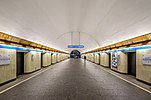
Hall of Petrogradskaya station in Saint Petersburg Metro
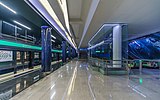
Novokrestovskaya metro station in Saint Petersburg Metro
Singapore[]
The Mass Rapid Transit (MRT) was the first rapid transit system in Asia to incorporate platform screen doors in its stations in 1987.[63] Full height PSDs mainly manufactured by Westinghouse are installed at all underground MRT and sub-surface stations, while Half-height platform screen doors were retrofitted into all elevated stations by March 2012. The LRT stations at Bukit Panjang, Sengkang and Punggol lack physical doors, only barriers with openings where the doors go (excluding the now-closed Ten Mile Junction station, which had full height doors) and vary in size according to their location on the platform.[citation needed]
There are two variants of the full-height platform screen doors in use. The first variant, made by Westinghouse, was installed at all underground stations along the North South line and the East West line from 1987 to the completion of the initial system in 1990. The second variant incorporating more glass on the doors has since been used on all lines thereafter.[citation needed]
Considered a novelty at the time of its installation, platform screen doors were introduced primarily to minimise hefty air-conditioning costs, especially since elevated stations are not air-conditioned and are much more economical to run in comparison. The safety aspects of these doors became more important in light of high-profile incidents where individuals were injured or killed by oncoming trains.[citation needed]
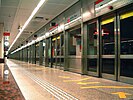
The first generation of platform screen doors at Raffles Place station, on the North South line.
Second-generation platform doors at Woodleigh station.
Half-height platform screen doors on elevated stations.

Newest generation platform screen doors on the Thomson-East Coast line.
South Korea[]

Yongdu station of Seoul Subway Line 2 was the first station on the Seoul Subway to feature platform screen doors; the station opened in October 2005. By the end of 2009, many of the 289 stations operated by Seoul Metro had platform doors by Hyundai Elevator.[64] Seoul Metro Lined 1, 2, 3, 4, 5, 6, 7, 8 and 9 were equipped with platform screen doors. However, not all stations operated by Korail have completed installation. All stations in South Korea will have platform screen doors by 2018.[65][needs update] As of 2017, 100% of subway stations are equipped with platform screen doors in Daejeon, Gwangju, Busan, Incheon and Daegu.[66]
The platform screen doors, installed in Munyang station in Daegu Metro Line 2 by The Korea Transport Institute in 2013, have a unique rope-based platform screen named Rope type Platform Safety Door (RPSD).[67] A door sets of rope blocks separate the platform from the rails. When the train arrives, the rope screen door sets are vertically opened and allow passenger boarding to and from the train. This RPSD was also used in Nokdong station on Gwangju Metro Line 1, but was removed in 2012, and a new full-height platform screen door was installed in 2016 instead.
Spain[]
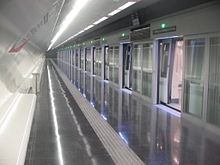
Half platform screens were installed first in Provença FGC station (Barcelona) around 2003. Later doors were tested on Barcelona Metro line 11 before fitting them on all stations for the new lines 9 and 10, which operate driverless.[citation needed] Platform doors are also found on the Madrid Barajas Airport People Mover at Adolfo Suárez Madrid–Barajas Airport.
Sweden[]
Stockholm commuter rail has platform doors on two underground stations opened in July 2017, as part of the Stockholm City Line.[68] The Stockholm Metro will test platform doors at Åkeshov metro station in 2015 & Bagarmossen metro station in 2021, the metro stations including Kungsträdgården metro station-Nacka Kungsträdgården metro station-Hagsätra metro station will have platform screen doors when it is completed between 2026-2030.[69] As there are multiple door layouts in use on the Stockholm Metro (a full length C20 having 21 doors on each side, and the older Cx series and newer C30 having 24), it is unlikely platform doors will be common anytime soon. The underground Liseberg station in Gothenburg has platform doors which were built before its opening 1993. The reason was safety against the freight trains that go in this tunnel. These doors are built one meter from the platform edge and do not restrict the train type.

Stockholm City commuter station

Older doors at Liseberg railway station in Gothenburg
Switzerland[]
Zurich International Airport's Skymetro shuttle between the main building (hosting terminals A and B) and the detached terminal E has glass screen doors separating the tracks from the passenger hall platforms at both ends.
Lausanne Metro's Line M2 has glass screen doors at every station.
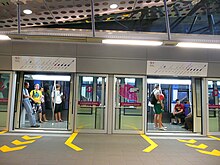
Taiwan[]
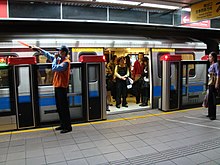
On Taipei Metro, platform screen doors were first installed on the Wenhu line (then known as Muzha line) in 1996. Older high-capacity MRT lines (Tamsui-Xinyi Line, Songshan-Xindian Line, Zhonghe-Xinlu line, and the Bannan Line) were initially constructed without platform screen doors but are retrofitted with automatic platform gates which is completed in 2018. Newer stations, on the Xinyi Line(part of the Tamsui-Xinyi Line), Luzhou and Xinzhuang Line (part of the Zhonghe-Xinlu Line), Songshan Line (part of the Songshan-Xindian Line), Circular Line, and part of the Bannan Line's Dingpu Station and Taipei Nangang Exhibition Center Station) are constructed with platform screen doors.
Thailand[]
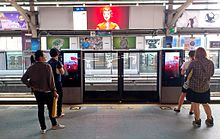
Platform Screen Doors were first installed on the BTS Skytrain & Bangkok MRT System since it first operates. Followed by the Airport Rail Link System in Makkasan Station (Express Platform) and Suvarnabhumi Station (both City and Express Line Platform. BTS Skytrain system first installed the Platform screen doors at Siam Station. Followed by all the busy stations during rush hours. Today, Almost all stations on the Bangkok Electrified Rail System have installed the Platform Screen Doors preventing people from falling onto the tracks. BTS Skytrain system has installed PSDs on 18 stations out of its 44 stations. Both Purple and Blue Line of Bangkok MRT system has installed PSDs on all of its stations. Airport Rail link has installed a stainless steel fence to prevent from falling but has not installed an automated door due to a speed of the train is too fast that it will break the glass. All new stations in Bangkok must install Platform screen doors as a rule.
Turkey[]
Platform doors are found on Istanbul Metro lines M5 and M7, both fully driverless. Some stations on line M2 also have platform doors.

Line M5 of the Istanbul Metro

Line M7 of the Istanbul Metro.
United Arab Emirates[]
Platform screen doors are installed on all the platforms in the fully automated Dubai Metro, as well as on the Dubai Airport People Mover, Palm Jumeirah Monorail and Dubai Tram (the world's first tram system to feature platform screen doors).
Dubai Metro Stations
Ibn Battuta Mall station on the Red line in Dubai Metro
United Kingdom[]

Platform screen doors at London Underground's Westminster

Jubilee Line Platforms at Waterloo

The Jubilee Line at Canada Water Platform 2.

Platform 2 at Canary Wharf
The Jubilee Line Extension project saw platform edge doors installed on its new stations that were underground, and were produced by Westinghouse.[70] There are plans to install PEDs in existing London Underground stations along the Bakerloo, Central, Piccadilly, and Waterloo & City lines as part of New Tube for London.[71] A provision for installing platform edge doors is found on the Northern line extension stations but no doors established due to the fact the trains that currently run on it do not support it.[72]
PEDs are present on the Gatwick Airport shuttle system, Heathrow Airport Terminal 5 airside people mover shuttle, Birmingham Airport AirRail Link and Stansted Airport Transit System.
The Elizabeth Line, the new cross-city line for London (delivered as the Crossrail Project) has Platform Screen Doors on each of the sixteen sub-surface platforms of its central section.[73] Each platform has twenty-seven doors which align with the twenty-seven saloon doors of the new British Rail Class 345 which will operate the service. The doors form a 2.5m high glass and steel screen the entire length of the platform. The system is unusual in that the trains served are full-sized commuter trains, larger and longer than the trains of metro systems more commonly equipped with Platform Screen Doors. In total, some 4km of platform screen is provided.
The Glasgow Subway will have half-height screen doors after new rolling stock are introduced in 2022.[74]
United States[]
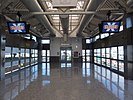
Terminal 5 station in AirTrain JFK in John F. Kennedy International Airport

Platform-level interior of P3 station in AirTrain Newark in Newark Liberty International Airport, 2008

An underground people mover, called The Plane Train, station at Hartsfield–Jackson Atlanta International Airport, Atlanta, United States
Interior of Terminal 1 station At AirTrain in San Francisco International Airport.

MIA Mover In Miami International Airport
Platform screen doors are rare in the United States, and with one exception, are exclusively found on small-scale systems. The Las Vegas Monorail system is currently the only general-purpose rapid transit system in the US to use platform screen doors. Honolulu Rail Transit will become the first large-scale publicly run metro system in the United States to feature platform screen doors, when it opens in 2022.
New York City's Metropolitan Transportation Authority has not committed to installing platform screen doors in its subway system, though it had been considering such an idea since the 1980s.[75] Their installation presents substantial technical challenges, in part because of different placements of doors on New York City Subway rolling stock.[76] Additionally, the majority of the system cannot accommodate platform doors regardless of door locations, due to factors such as narrow platforms and structurally insufficient platform slabs (see Technology of the New York City Subway § Platform screen doors).[77][78] Following a series of incidents during one week in November 2016, in which three people were injured or killed after being pushed into tracks, the MTA started to consider installing platform edge doors for the 42nd Street Shuttle.[79] In October 2017, the MTA formally announced that platform screen doors would be installed at the Third Avenue station on the L train as part of a pilot program,[80][81] but the pilot was later postponed.[82] Following several pushing incidents, the MTA announced a PSD pilot program at three stations in February 2022: the 7 and <7> trains' platform at Times Square; the E train's platform at Sutphin Boulevard–Archer Avenue–JFK Airport; and the Third Avenue station.[83][84]
People movers, systems that ferry passengers across large distances they would otherwise walk, make use of platform screen doors. These systems are common at airports such as Hartsfield–Jackson Atlanta International Airport and Denver International Airport. The Port Authority of New York and New Jersey uses full height platform screen doors at two of its systems: AirTrain JFK and AirTrain Newark (serving John F. Kennedy International Airport and Newark Liberty International Airport respectively). San Francisco International Airport has AirTrain, a 6-mile-long line whose stations are fully enclosed with platform screen doors, allowing access to the fully automated people mover.[citation needed] Chicago O'Hare International Airport has a people mover system which operates 24 hours a day and is a 2.5 mile long (4 km) line that operates between the four terminals at the airport and parking areas; each station is fully enclosed with platform screen doors allowing access to the fully automated people mover trains. AeroTrain is a 3.78-mile (6.08 km) people mover system at Washington Dulles International Airport in Dulles, Virginia with fully enclosed tracks including platform screen doors. The United States Capitol subway system, a train cart people mover system, uses platform gates.
Venezuela[]
Platform screen doors are in use on the Los Teques Metro. The first station to have screen doors implemented on the system was Guaicaipuro.[85]
Incidents[]
On the Shanghai Metro in 2007, a man forcing his way onto a crowded train became trapped between the train door and platform door as they closed. He was pulled under the departing train and killed.[86] In 2010, a woman in Shanghai's Zhongshan Park Station was killed[87] under the same circumstances when she got trapped between the train and platform doors. An almost identical death occurred on the Beijing Subway in 2014 —the third death involving platform doors in China within the several years preceding it.[88][89] In 2018, a woman was similarly trapped between the platform doors and train at Shanghai's Bao'an Highway station. She escaped injury by standing still as the train departed.[90] On January 22, 2022, an elderly woman was killed when she got trapped between the train doors and platform screen doors at Shanghai's Qi'an Road Station.[91]
Between 1999 and 2012, London Underground's platform doors, all on Jubilee Line, were involved in 75 injuries, including strikes to heads and arms.[92]
References[]
- ^ "What Are Platform Screen Doors?". wiseGEEK. 7 February 2022. Retrieved 23 February 2022.
- ^ US 915122A, Shute, Charles S, "Safety fence and gate for railway-platforms.", issued 1908-05-26
- ^ USA Patent Office (1872). Official Gazette of the United States Patent Office. U.S. Government Printing Office. p. 8-PA536. Retrieved 31 December 2020.
- ^ US 1259060A, West, C. A., "Gate for subrailways and the like.", issued 1917-06-22
- ^ Electric Traction. Kenfield-Davis Publishing Company. 1919. p. 314. Retrieved 31 December 2020.
- ^ a b "PLATFORM SCREEN DOORS". Metrobits. Retrieved 30 September 2021.
- ^ "Platform Screen Doors: No barrier to success". Intelligent Transport. 19 April 2007. Retrieved 30 September 2021.
- ^ "Mind the Gap". Railway Technology. 9 February 2009. Retrieved 30 September 2021.
- ^ "Lille VAL". Railway Techology. Retrieved 30 September 2021.
- ^ a b c d "Platform Screen Doors: No barrier to success". Intelligent Transport. 19 April 2007. Retrieved 25 September 2019.
- ^ "DIY railway litter patrol banned". BBC News. 26 May 2006. Retrieved 27 September 2019.
- ^ PDF on the issue (London Underground): Personal Exposure and Air Quality in Northbank Archived 28 November 2018 at the Wayback Machine
- ^ "Manusa - website on Automatic Platform Gate". Archived from the original on 26 August 2016. Retrieved 16 November 2010.
- ^ "APSD METRO SOFIA". Archived from the original on 21 December 2021 – via www.youtube.com.
- ^ Plan de modernización del Subterráneo de Buenos Aires – Buenos Aires Ciudad
- ^ Piccardo presentó en Brasil el Plan de Modernización del Subte – EnElSubte, 18 September 2015.
- ^ "Licitan nuevo señalamiento para la línea D". EnElSubte (in European Spanish). 22 June 2016. Retrieved 7 July 2016.
- ^ "Australia's Biggest Public Transport Project | Sydney Metro". www.sydneymetro.info.
- ^ Preiss, Benjamin; Mannix, Liam (12 May 2016). "Cue new screen doors at Metro rail stations, but you will need new queuing technique". The Age. Retrieved 29 October 2017.
- ^ Ong, Sing Yee (16 April 2021). "ST Engineering enters Australia rail market with Queensland's Cross River Rail contract win". The Business Times. Retrieved 23 October 2021.
- ^ "Wie der U2-Tunnel zwischen Volkstheater und Rathaus ausgeweidet wird". DER STANDARD (in Austrian German). Retrieved 7 August 2021.
- ^ "Platform screen doors installed in Minsk metro". TV channel «Belarus 24». Retrieved 6 March 2020.
- ^ "Linha 4-Amarela é eleita a melhor pelos paulistanos | ViaQuatro".
- ^ "Serra inaugura estação Sacomã do Metrô". Governo do Estado de São Paulo. 30 January 2010.
- ^ "Governo de SP contrata instalação de portas de plataforma do Metrô". Governo do Estado de São Paulo. 12 June 2019.
- ^ "Portas de Plataforma em toda a linha 5 Lilás serão entregues até 2020, diz Pelissioni". 31 August 2018.
- ^ "EMTU conclui instalação de portas plataforma em estação do VLT". 7 November 2016.
- ^ "Sofia awards metro contract to Siemens and Newag". International Railway Journal. 15 March 2016. Retrieved 17 December 2019.
- ^ "Фандъкова: Готови са автоматичните предпазни врати на метростанция "Опълченска" - Труд". trud.bg.
- ^ "WPSD Platform Screen Door System - Case Study". Platformscreendoors.com. Archived from the original on 26 June 2008. Retrieved 1 August 2009.
- ^ "Vuosaari platform doors introduced on 15 February". HKL. 17 February 2012. Archived from the original on 13 May 2013. Retrieved 20 March 2012.
- ^ "Vanves-Malakoff : les rideaux de quais bientôt en action !". Le blog des Lignes N et U - Transilien. 29 June 2020. Quand seront-ils en fonctionnement ?. Archived from the original on 1 July 2020. Retrieved 1 July 2020.
- ^ "Vanves-Malakoff : les rideaux de quais bientôt en action !". Le blog des Lignes N et U - Transilien. 29 June 2020. Comment les rideaux de quais fonctionnent-ils ?. Archived from the original on 1 July 2020. Retrieved 1 July 2020.
- ^ muenchen.de. "Können Bahnsteigtüren die Sicherheit der U-Bahn erhöhen?". muenchen.de (in German). Retrieved 7 August 2021.
- ^ "TECHNICAL CONSULTANT SERVICES FOR THESSALONIKI METRO PROJECTS" (PDF). 11 September 2018. Archived from the original (PDF) on 11 September 2018. Retrieved 7 February 2020.
- ^ a b "Updated background brief on installation of platform screen doors and automatic platform gates at railway stations" (PDF). Legislative Council. 2 March 2012.
- ^ "LCQ16: Retrofitting of PSDs at MTR stations to be completed by 2006". HKSAR Government Information Centre. 5 January 2005. Retrieved 17 June 2007.
- ^ Feng, Frank (22 July 2015). "Hong Kong MTR passengers to be spared platform screen door costs". South China Morning Post.
- ^ Law, C.K.; Yip, P.S.F. (30 January 2011). "An economic evaluation of setting up physical barriers in railway stations for preventing railway injury: evidence from Hong Kong". Journal of Epidemiology and Community Health. 65 (10): 915–920. doi:10.1136/jech.2010.115188. hdl:10072/61569. PMID 21282146. S2CID 41988348.
- ^ "東鐵不裝幕門被轟為慳錢" (in Chinese). Apple Daily. 4 July 2005.
- ^ "Contracts". Sha Tin to Central Link. MTR Corporation. Archived from the original on 4 March 2016. Retrieved 23 November 2015.
- ^ "Knorr-Bremse". www.westinghouse-brakes.com. Retrieved 26 September 2019.
- ^ "Shun Hing Systems Integration Co., Ltd". www.shunhingsi.com. Retrieved 26 September 2019.
- ^ "Media Kit - Airport Express". Reliance Airport Express Metro. Archived from the original on 29 August 2011. Retrieved 9 November 2011.
- ^ "Delhi Metro to have driver less trains". Archived from the original on 21 April 2015.
- ^ Sekar, Sunitha. "Platform screen doors to be installed in Metro stations". The Hindu. Retrieved 21 May 2017.
- ^ "Metro to get platform screen doors". The Times of India. 5 January 2011. Archived from the original on 11 November 2013. Retrieved 9 November 2011.
- ^ Ashok, Sowmiya (1 August 2014). "Delhi Metro to get platform screen doors by Nov. 2015". The Hindu – via www.thehindu.com.
- ^ "PSD Installation Begins at Mumbai Metro Line-2A's Stations". The Metro Rail Guy. 27 February 2021. Retrieved 21 April 2021.
- ^ "Alstom Wins Mumbai Metro Line-4's Signaling & PSD Contract". The Metro Rail Guy. 19 April 2021. Retrieved 21 April 2021.
- ^ "Mumbai Metro Line-7's 1st Platform Screen Door Installed". The Metro Rail Guy. 2 March 2021. Retrieved 21 April 2021.
- ^ Shah, Narendra (10 December 2018). "Alstom signs signallling, PSD & Telecom contract of Mumbai Metro Line 3". Metro Rail News. Retrieved 21 April 2021.
- ^ "Maha Metro invites tender for Supply and Commissioning of Platform Screen Doors System". Rail Analysis India. 6 November 2021. Retrieved 23 January 2022.
- ^ Asahi Shimbun Keeping commuters safe; mobile station barriers 20 October 2011 Archived 11 November 2013 at the Wayback Machine
- ^ Ushijima, Kota (13 November 2012). "Progress stalls on installing platform barriers at train stations nationwide". Daily Yomiuri. Archived from the original on 18 February 2013. Retrieved 29 October 2017.
- ^ 15 car trains at 20m lengths, totaling approximately 300m
- ^ "新小岩駅の総武快速線ホームドア、2月以降に着工 2018年度使用開始". レスポンス(Response.jp).
- ^ Department of Transportation The Republic of the Philippines (October 2018). "FEASIBILITY STUDY ON THE NORTH SOUTH RAILWAY PROJECT-SOUTH LINE (COMMUTER)(NORTH-SOUTH COMMUTER RAILWAY EXTENSION PROJECT) IN THE REPUBLIC OF THE PHILIPPINES" (PDF). jica.go.jp.
- ^ "METRO MANILA SUBWAY PROJECT PHASE 1". Department of Transportation (Philippines). December 2019. (Refer to Report CPCP106: E&M SYSTEMS AND TRACK WORKS Volume II of IV PART 2: "EMPLOYER’S REQUIREMENTS")
- ^ "Finmeccanica wins a USD 1.2 billion contract for Lima Metro". www.leonardocompany.com. Retrieved 8 October 2021.
- ^ "Platform screen doors installed at Metro station". Gulf-Times (in Arabic). 30 March 2018. Retrieved 17 December 2019.
- ^ Cooke, B.W.C., ed. (November 1959). "Sliding Doors on Platform Edge". The Railway Magazine. Vol. 105, no. 703. Westminster: Tothill Press. p. 796.
- ^ Westinghouse Platform Screen Doors - Completed Projects Archived 13 February 2008 at the Wayback Machine
- ^ "[5678 NEWS] 제4회 부산국제철도 및 물류산업전(RailLog Korea 2009". 행복미소 장지역 - Daum 카페.
- ^ 잇단 투신에도...국철 스크린도어 설치는 '서행' Hankooki.com (in Korean) Archived 14 January 2013 at the Wayback Machine
- ^ 문병호 의원, 기존 전철역에도 스크린도어 설치 국비지원을 스크린도어 설치로 인한 자살예방 효과 탁월 Asia News Agency (in Korean)
- ^ 기자, 노진실 이현덕 (5 February 2015). "1225억짜리! 공사 수주전 전국서 군침". 영남일보.
- ^ "Citybanans stationer - Trafikverket". Archived from the original on 11 October 2015.
- ^ "Fullskaletest av plattformsbarriärer på Bagarmossens tunnelbanestation".
- ^ "Westinghouse Platform Screen Doors". Platformscreendoors.com. Retrieved 1 August 2009.
- ^ "New Tube for London Feasibility Report October 2014" (PDF). tfl.gov.uk. Transport for London. October 2014. p. 18. Retrieved 12 December 2016.
- ^ New Battersea Tube Extension - Your Questions Answered, archived from the original on 21 December 2021, retrieved 4 October 2021
- ^ "Floor-to-ceiling Platform Screen Doors". Crossrail. Retrieved 8 February 2021.
- ^ "'Confrontational' talks as Glasgow Subway driverless trains delayed to 2022". The Scotsman. 11 December 2020.
- ^ Neuman, William (5 April 2007). "2nd Ave. Subway Platforms May Get Glass Walls and Sliding Doors". The New York Times. ISSN 0362-4331. Retrieved 12 January 2017.
- ^ "Capitalnewyork.com". www.capitalnewyork.com. Archived from the original on 23 March 2014.
- ^ Rivoli, Dan (20 January 2022). "Docs show costs and challenges of subway track safety". Spectrum News NY1 | New York City. Retrieved 26 January 2022.
- ^ "Politicians call for subway platform gates after fatal New York crimes". Trains. 25 January 2022. Retrieved 26 January 2022.
- ^ Furfaro, Danielle (15 November 2016). "MTA boss makes another push for subway platform doors". New York Post. Retrieved 16 November 2016.
- ^ Barone, Vin (24 October 2017). "Platform door pilot heads to L train station". am New York. Archived from the original on 25 October 2017. Retrieved 25 October 2017.
- ^ Furfaro, Danielle (25 October 2017). "MTA to test barrier to stop people from falling on tracks". New York Post. Retrieved 25 October 2017.
- ^ Berger, Paul (26 June 2018). "MTA Postpones Platform-Safety Pilot Program". Wall Street Journal. ISSN 0099-9660. Retrieved 26 June 2018.
- ^ Gold, Michael (23 February 2022). "Subway Will Test Platform Doors at 3 Stations". The New York Times. ISSN 0362-4331. Retrieved 23 February 2022.
- ^ Brosnan, Erica (23 February 2022). "MTA: Platform barrier pilot program to launch in three stations". Spectrum News NY1 | New York City. Retrieved 23 February 2022.
- ^ cugueto (5 June 2013). "Metro Los Teques implementa sistema de seguridad de puertas de andén". MippCI (in Spanish). Retrieved 21 March 2021.
- ^ "Man caught between subway train and safety doors dies in Shanghai". International Herald Tribune. 29 March 2009. Archived from the original on 18 August 2007. Retrieved 1 August 2009.
- ^ "Woman killed in subway accident in Shanghai". www.chinadaily.com.cn. Retrieved 25 January 2022.
- ^ "Beijing subway passengers tried to raise alarm before accident victim was dragged to her death". South China Morning Post. 7 November 2014.
- ^ "Passenger crushed to death while trying to board subway train in Beijing-Sino-US". Archived from the original on 18 August 2018. Retrieved 11 November 2014.
- ^ Tang, Frank (26 April 2018). "Chinese woman trapped behind subway safety doors as train speeds by". South China Morning Post.
- ^ 郭凯. "Woman dies after incident at Shanghai metro". global.chinadaily.com.cn. Retrieved 25 January 2022.
- ^ "HTML version of an attachment to the Freedom of Information request 'Safety of platform screen doors'". WhatDoTheyKnow. 17 January 2012. Retrieved 24 October 2016.
External links[]
 Media related to Platform screen doors at Wikimedia Commons
Media related to Platform screen doors at Wikimedia Commons
- Air pollution control systems
- Building biology
- Building engineering
- Construction
- Doors
- Heating, ventilation, and air conditioning
- Mechanical engineering
- Noise control
- Protective barriers
- Railway platforms
- Railway safety
- Rapid transit
- Security engineering
- Security technology
- Soviet inventions
- Suicide prevention
- Train protection systems
- Vehicle safety technologies
























































